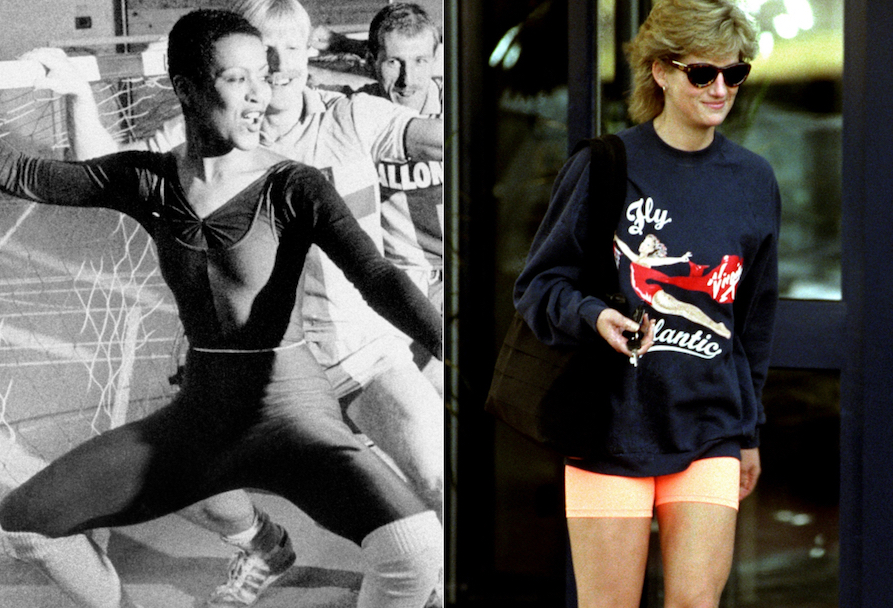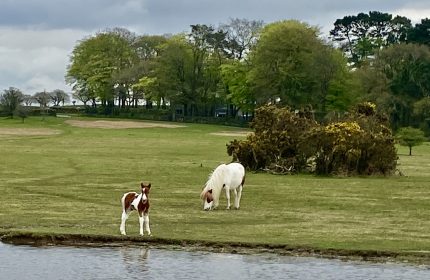Fitness fashion through the decades, from leotards to athleisure
Athleisure is now so ubiquitous that it’s hard to imagine what life was like before Lycra leggings and sporty crop tops were standard uniform.
Long gone are the days where it was deemed socially unacceptable to wear workout gear anywhere other then the gym. But how did we get here?
Even though fitness clothes have only recently become a part of our everyday wardrobe, they’ve – obviously – been around for decades, and fitness fashion is as susceptible to changing trends as any other type of clothing.
Working out hasn’t always been easily accessible for women, which has had an even bigger impact on trends. Here’s a look back at how we’ve dressed for exercise through the decades, from the 1950s to today.
1950s

For many women, exercising in the 1950s was vastly different to what it’s like today. Few had access to a gym they could go to regularly, which is probably why this was the era of the hula hoop – something women could do at home. With this in mind, there wasn’t a huge amount of choice when it came to exercise clothes. Women were generally limited to short shorts and collared tops that looked more like a swimming costume or gymnast’s outfit than something suitable for going for a run.
1960s

Unfortunately, things didn’t improve much in the Sixties. Organised exercise was still pretty rare for women, so not a great deal of effort was put into what they would wear when working out.

Like the 1950s, the normal sporting uniform (for both women and men) were short shorts, a T-shirt (normally collared for propriety) and long socks to the knee.
1970s

Amazingly, the very first sports bra was only invented in the 1970s. Before that, many women would no doubt have been put off exercising as they didn’t have proper support, which as many women know, can be painful as well as impractical.
During this era, female sportswear in general seemed to move forward, and actually begin to look suitable for exercise. Think tracksuits and sporty shorts and shirts that are designed to be suitable and comfortable.

This was also the decade that gifted us the blessing that is ‘Jazzercise’, giving increasingly more women a way to exercise. This had a knock-on effect in encouraging a bit more experimentation in the fitness fashion department.
1980s

Jazzercise was but a taster for the glory of the 1980s, however. Thanks to Jane Fonda and the explosion in popularity of aerobics, increasingly more women were regularly working out (no doubt with the added help of the freshly invented sports bra). This is also when people started realising that looking good in their gym kit was important to them too.

In terms of fashion trends, this was the era of excess – think bright leggings, legwarmers, leotards and big hair to match. And hey, it must have all worked, because at 80 years old, Fonda still looks utterly amazing now.
1990s

Perhaps thankfully, legwarmers and leotards faded into obscurity when the Nineties came around. But that doesn’t mean the fashions in fitness clothing changed completely. Trends still held on to some aspects of Eighties gymwear – for example, clothes were still tight, just in the form of separates instead of one-pieces.
Patterns and colours became brighter and more varied – something that is remarkably similar to the fashions for today, as it happens.

Princess Diana sporting her gym kit
Long gone were the days of the 1950s and 60s, where women didn’t really have an outlet to exercise, let alone suitable gear to wear while doing it. More and more gyms began opening up and welcoming women through their doors – in fact, exercise became such an acceptable pastime that even princesses were seen working out regularly.
2000s

It’s not exactly a decade that’s known for its fashion credentials, instead bringing us sartorial howlers like Von Dutch trucker hats and Juicy Couture tracksuits.
Unfortunately, the fashion in fitness was not immune in this disastrous era. Trends moved away from bright colours and sleek Lycra and instead gym-goers favoured darker tones, baggy fits and, frankly dodgy, tracksuits.

CrossFit was founded in 2000 and soon swept the globe, and anyone who’s familiar with the format will know that it’s not exactly a fashion hotspot…
2010s

And now on to present day. We live in a world where athleisure is king, with everyone from expensive brands like Balenciaga, through to high street favourites getting in on the action.
Now we’ve started wearing our gym kit everywhere and anywhere, it’s understandable that a lot more thought has been put into its design.

Like in the 1980s and 90s, gym leggings are sleek – they tend to be brightly coloured if you’re actually working out, but a plain black if you’re wearing them to brunch. We’re also much more likely to see women in the gym wearing a crop top-style sports bra and no top over it, which would have been unheard of previously.
The athleisure trend has particularly transformed the footwear industry. Trainers are one of the most ubiquitous type of shoe now, and the line between something you can wear at the gym and one for the streets (or even a night out) has become increasingly blurred.

It’s no coincidence that Nike’s global revenue grew by 150% between 2005 and 2017. And hey – if having all the right gear is encouraging more women to exercise, then that can only be a good thing. Even if women aren’t working out much more, at least wearing leggings is a whole lot more comfortable than jeans.
The Press Association
Latest posts by The Press Association (see all)
- Kate’s new photo of Louis released to celebrate prince’s sixth birthday - April 23, 2024
- Alan Titchmarsh: Slugs are never going to be my friends - April 23, 2024
- Prince Louis celebrates sixth birthday - April 23, 2024
- Special episode of Planet Earth III to be narrated by schoolchildren - April 22, 2024
- Earth Day: 5 surprising things that might be harming the planet - April 21, 2024





















